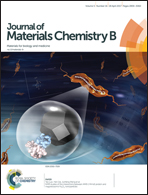Cross-linked antifouling polysaccharide hydrogel coating as extracellular matrix mimics for wound healing†
Abstract
Conventional wound dressings cannot provide an appropriate environment for tissue repair and regeneration and easily adhere to wounds causing damage to the new epithelial tissues, which leads to bleeding. Herein, a new antifouling hydrogel based on a natural polysaccharide was developed for wound healing. The biocompatible hydrogel with an ideal three-dimensional network composited of chitosan and dextran was synthesized by the Michael addition reaction. The hydrogel showed good swelling and cytocompatibility against NIH3T3. Moreover, the antifouling hydrogel was obtained by adjusting the proportion of positive and negative charges of chitosan and dextran. Antifouling hydrogels overcoming the deficiency of traditional wound dressings could inhibit bacterial and cellular adhesion effectively and also be applied as a carrier for protein delivery. After the wound was treated by bFGF-loaded hydrogels, significantly greater wound contraction was observed, which demonstrated their superior healing activity to promote fibroblast migration, granulation tissue formation and angiogenesis by up-regulation of VEGF and PCNA expression. These results showed that the obtained antifouling hydrogel may be a promising therapeutic strategy for managing diabetic ulcers.



 Please wait while we load your content...
Please wait while we load your content...